Table of Contents
Introduction
AI in Agriculture Statistics: Artificial Intelligence (AI) is quickly transforming agriculture. It empowers farmers and agribusinesses to optimize practices, increase productivity, and prioritize sustainability. AI-driven precision farming efficiently manages resources like water, fertilizers, and pesticides, leading to higher yields with less environmental impact.
These AI systems also monitor crop and livestock health for early issue detection. Furthermore, AI enhances supply chain efficiency, ensuring smooth product delivery. Despite challenges like data privacy and adoption hurdles, AI integration has the potential to revolutionize agriculture, making it more efficient, sustainable, and responsive to global food needs.
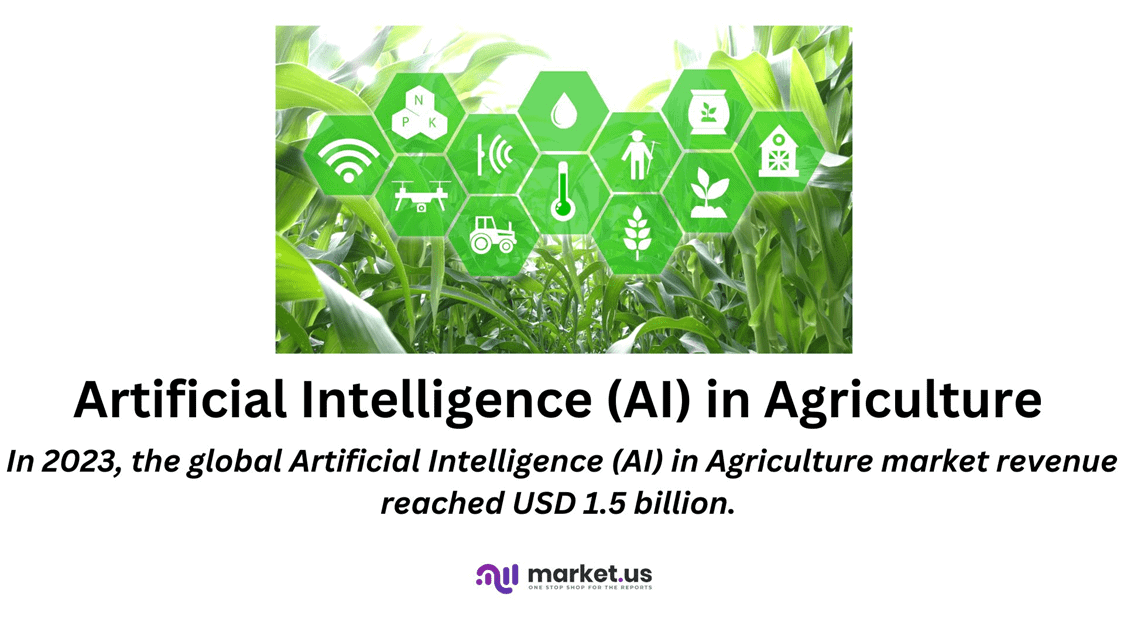
Editor’s Choice
- In 2023, the global Artificial Intelligence (AI) in Agriculture market revenue reached USD 1.5 billion.
- This upward trend continues with the market expanding to USD 1.8 billion in 2024, USD 2.4 billion in 2025, and USD 3.0 billion in 2026, with each AI segment showing increased revenues.
- The software component commands the largest share, comprising 45.2% of the market, emphasizing the pivotal role of AI software solutions in transforming agricultural practices.
- Field farming continues to hold the largest share, with 61.1% in 2019 and a slightly increased 61.5% in 2024, reaffirming its dominance in the industry.
- Farm management takes the lead with a substantial 35% utilization of IoT and AI, streamlining operations and enhancing productivity.
- Precision farming and irrigation monitoring & controlling share the lead with 16% each, emphasizing the importance of precise resource management in agriculture.
- In April 2021, India and the United States launched the US-India Artificial Intelligence (USIAI) Initiative through the Indo-U.S. Science and Technology Forum (IUSSTF), a jointly funded autonomous organization. This initiative enables India to harness American AI technology to enhance food grain production in agriculture.
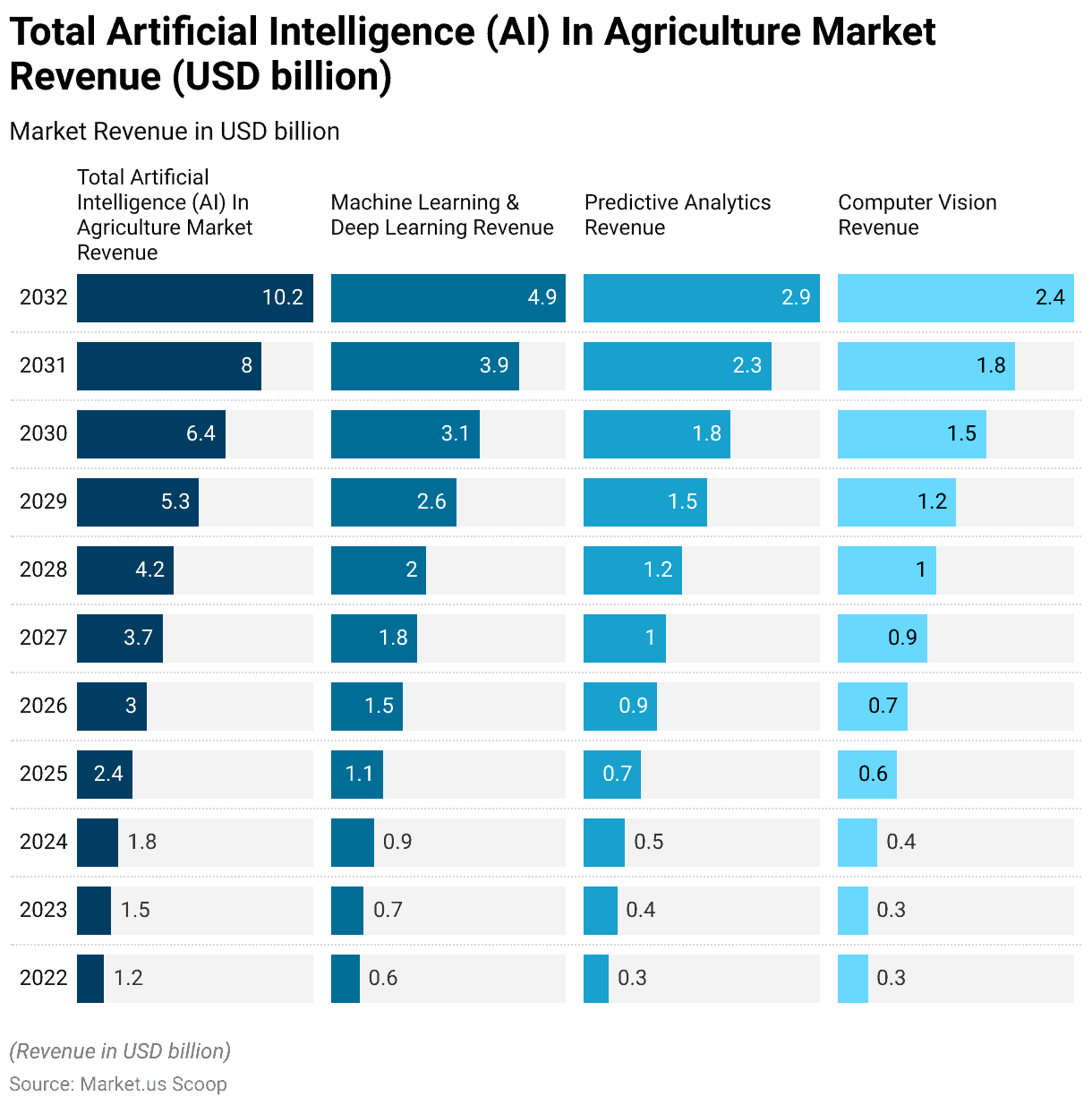
AI In Agriculture Market Statistics
Global Artificial Intelligence AI In Agriculture Market Size Statistics
- The global Artificial Intelligence (AI) in Agriculture market is on a significant growth trajectory at a CAGR of 24.5%.
- In 2022, the market generated USD 1.2 billion in revenue, and this figure is expected to steadily rise in the coming years.
- In 2023, it is projected to reach USD 1.5 billion, followed by USD 1.8 billion in 2024.
- As we progress further, the market’s growth becomes even more pronounced, with revenues estimated at USD 2.4 billion in 2025, USD 3.0 billion in 2026, and USD 3.7 billion in 2027.
- Looking ahead, the market is poised for substantial expansion, with revenues forecasted to reach USD 4.2 billion in 2028, USD 5.3 billion in 2029, USD 6.4 billion in 2030, USD 8.0 billion in 2031, and a remarkable USD 10.2 billion in 2032.
- This growth reflects the increasing adoption of AI technologies in agriculture, driven by the industry’s pursuit of efficiency, sustainability, and enhanced productivity in food production.
(Source: Market.us)
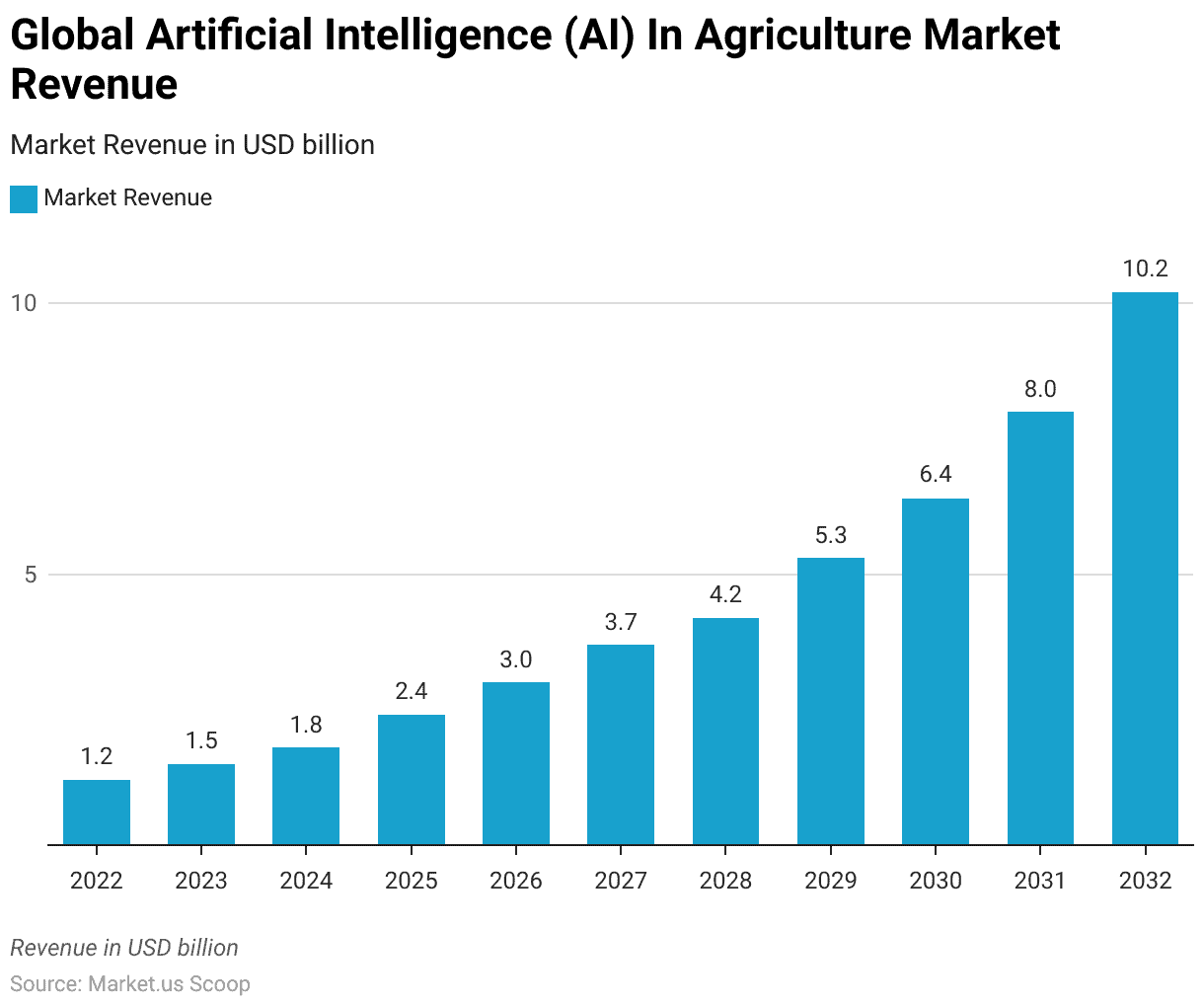
AI In Agriculture Market Size – By Resolution Statistics
- The Global Artificial Intelligence (AI) in the Agriculture market is experiencing substantial growth, with various AI technologies contributing to its expansion.
- In 2022, the total market revenue reached USD 1.2 billion. Among the key AI components, Machine Learning & Deep Learning generated USD 0.6 billion in revenue, while Predictive Analytics and Computer Vision each accounted for USD 0.3 billion.
- As we look ahead, the market is set to see continuous growth, reaching USD 1.5 billion in 2023, with Machine Learning & Deep Learning contributing USD 0.7 billion, Predictive Analytics at USD 0.4 billion, and Computer Vision remaining at USD 0.3 billion.
- This upward trend continues with the market expanding to USD 1.8 billion in 2024, USD 2.4 billion in 2025, and USD 3.0 billion in 2026, with each AI segment showing increased revenues.
- The market is expected to reach remarkable figures by 2032, with a total revenue of USD 10.2 billion, driven by significant contributions from Machine Learning & Deep Learning, Predictive Analytics, and Computer Vision, emphasizing the growing importance of AI technologies in the agriculture sector.
(Source: Market.us)
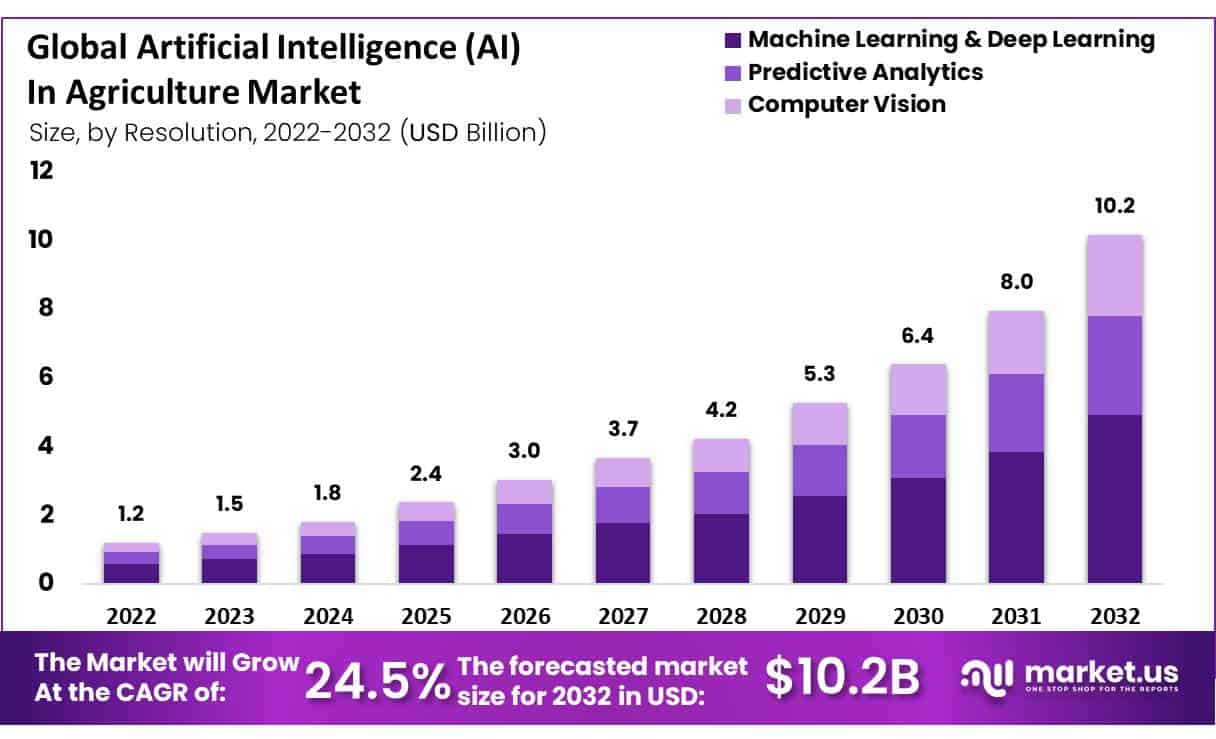
AI In Agriculture Market Share – By Component Statistics
- The Global Artificial Intelligence (AI) in Agriculture market exhibits a diverse landscape in terms of market share by component.
- Software commands the largest share, comprising 45.2% of the market, emphasizing the pivotal role of AI software solutions in transforming agricultural practices.
- Hardware follows closely, accounting for 24.5% of the market share, underscoring the importance of the physical infrastructure that supports AI implementations in agriculture.
- Services contribute significantly as well, with an 18.0% market share, highlighting the demand for expert services to assist in AI adoption.
- AI-as-a-Service rounds out the components with a share of 12.3%, reflecting the increasing popularity of cloud-based AI solutions that offer scalability and accessibility to agribusinesses.
- This distribution of market share showcases the multidimensional nature of AI’s presence in the agriculture sector, with software, hardware, services, and AI-as-a-service all playing integral roles in its growth and evolution.
(Source: Market.us)
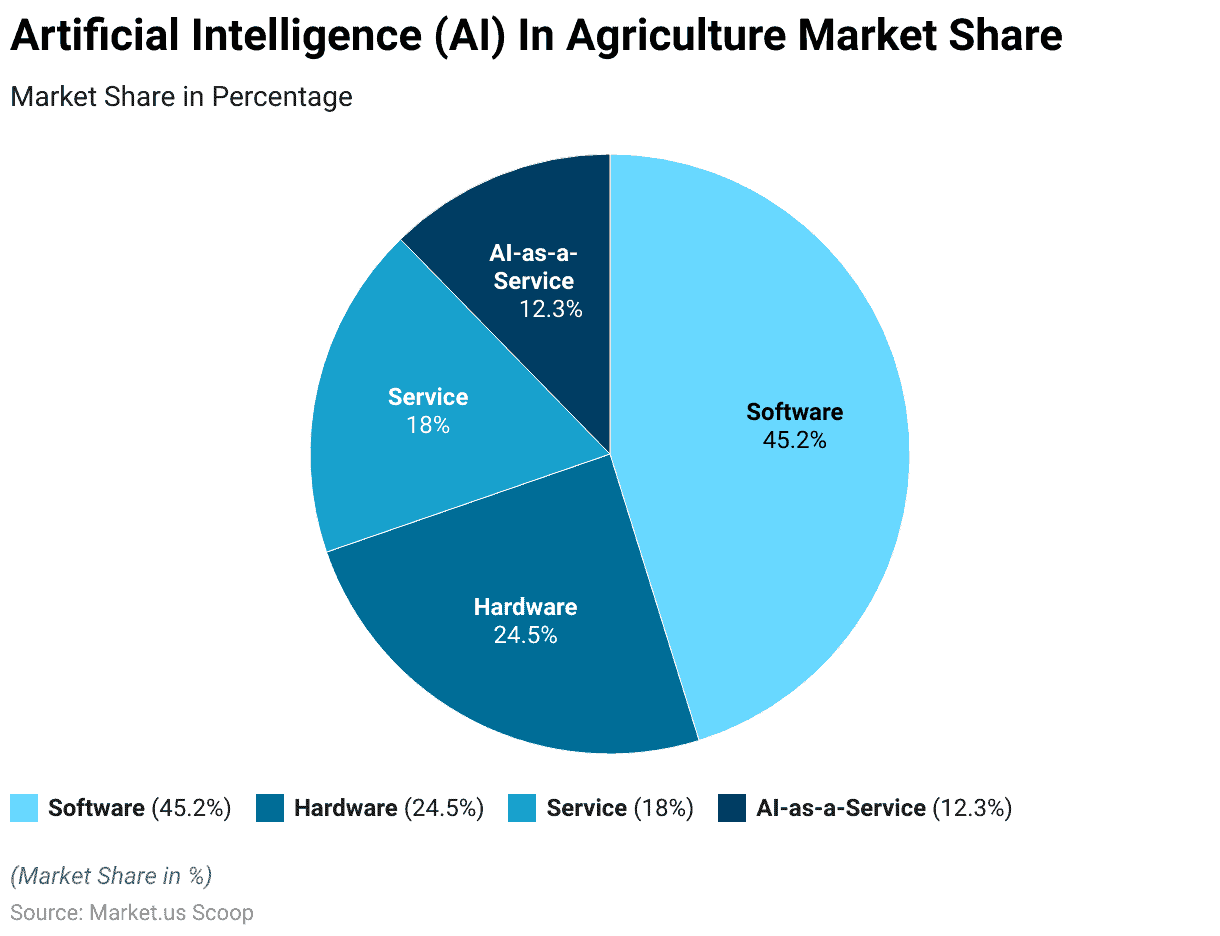
Global AI in Agriculture Market Share – By Farming Type Statistics
- The Global Artificial Intelligence in Agriculture market share, categorized by farming type, displays a stable distribution between 2019 and 2024.
- Field farming continues to hold the largest share, with 61.1% in 2019 and a slightly increased 61.5% in 2024, reaffirming its dominance in the industry.
- Livestock farming follows, accounting for 18.1% in 2019 and showing a modest rise to 19.1% in 2024, indicating a gradual but steady expansion in this sector.
- Indoor farming maintains its presence with a share of 15.2% in 2019, slightly decreasing to 15.0% in 2024, remaining a significant segment in AI adoption.
- Lastly, other farming types represented 5.6% in 2019, experiencing a slight decline to 4.4% in 2024, reflecting a minor shift in focus within the agricultural AI landscape.
- This distribution illustrates the consistent prominence of field farming, with livestock farming and indoor farming steadily evolving, while other farming types undergo minor adjustments over the specified period.
(Source: Statista)
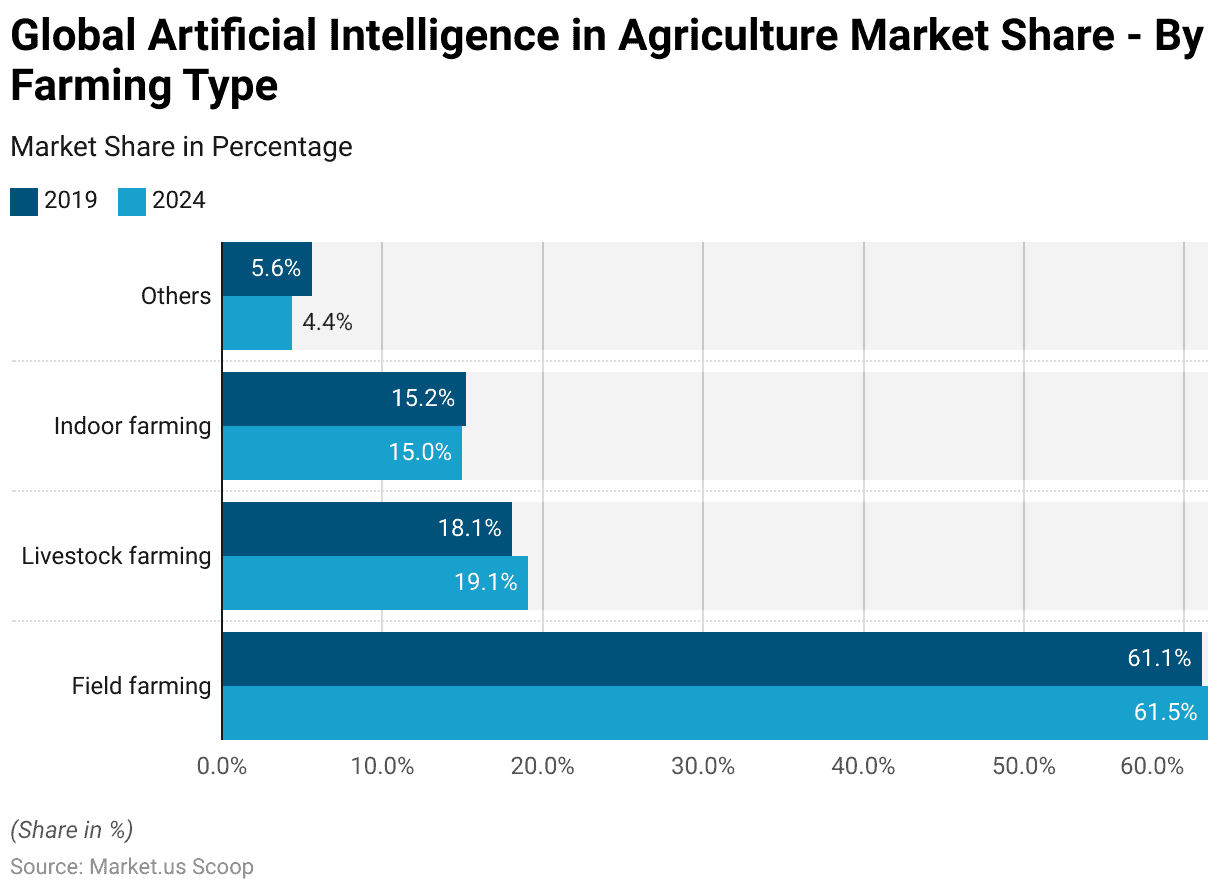
Use of IoT and AI in Precision Agriculture
- The integration of the Internet of Things (IoT) and Artificial Intelligence (AI) technologies has significantly impacted various aspects of precision agriculture activities.
- Farm management takes the lead with a substantial 35% utilization of IoT and AI, streamlining operations and enhancing productivity.
- Weather forecast systems follow closely, representing 20% of the application, enabling farmers to make informed decisions based on real-time weather data.
- Agriculture learning and information systems contribute 15%, promoting knowledge sharing and continuous improvement in farming practices.
- Pest control stands at 13%, utilizing IoT and AI for efficient monitoring and prevention.
- Crop market management captures 10%, aiding in market analysis and strategic decision-making.
- The agriculture support chain and business segment accounts for 7%, facilitating seamless operations across the agricultural supply chain.
- This comprehensive integration of IoT and AI underscores their pivotal role in enhancing precision agriculture across a spectrum of activities, from farm management to market strategies and beyond.
(Source: Springer Link)

IoT Agriculture Applications
- Internet of Things (IoT) applications in agriculture encompass a wide range of functions, each contributing to the enhancement of farming practices.
- Precision farming and irrigation monitoring & controlling share the lead with 16% each, emphasizing the importance of precise resource management in agriculture.
- Soil monitoring follows closely at 13%, ensuring optimal soil conditions for crop growth.
- Temperature and humidity monitoring hold 12% and 11%, respectively, aiding in climate control and crop health assessment.
- Animal monitoring & tracking, also at 11%, facilitates livestock management and welfare.
- Water monitoring & controlling is at 7%, helping in efficient water resource utilization.
- Air monitoring and disease monitoring each account for 5%, addressing environmental and health factors.
- Finally, fertilization monitoring makes up 4%, emphasizing the significance of balanced nutrient management.
- This diverse range of IoT applications underscores their critical role in modernizing agriculture, from precision farming to environmental sustainability and overall farm efficiency.
(Source: Research Gate)
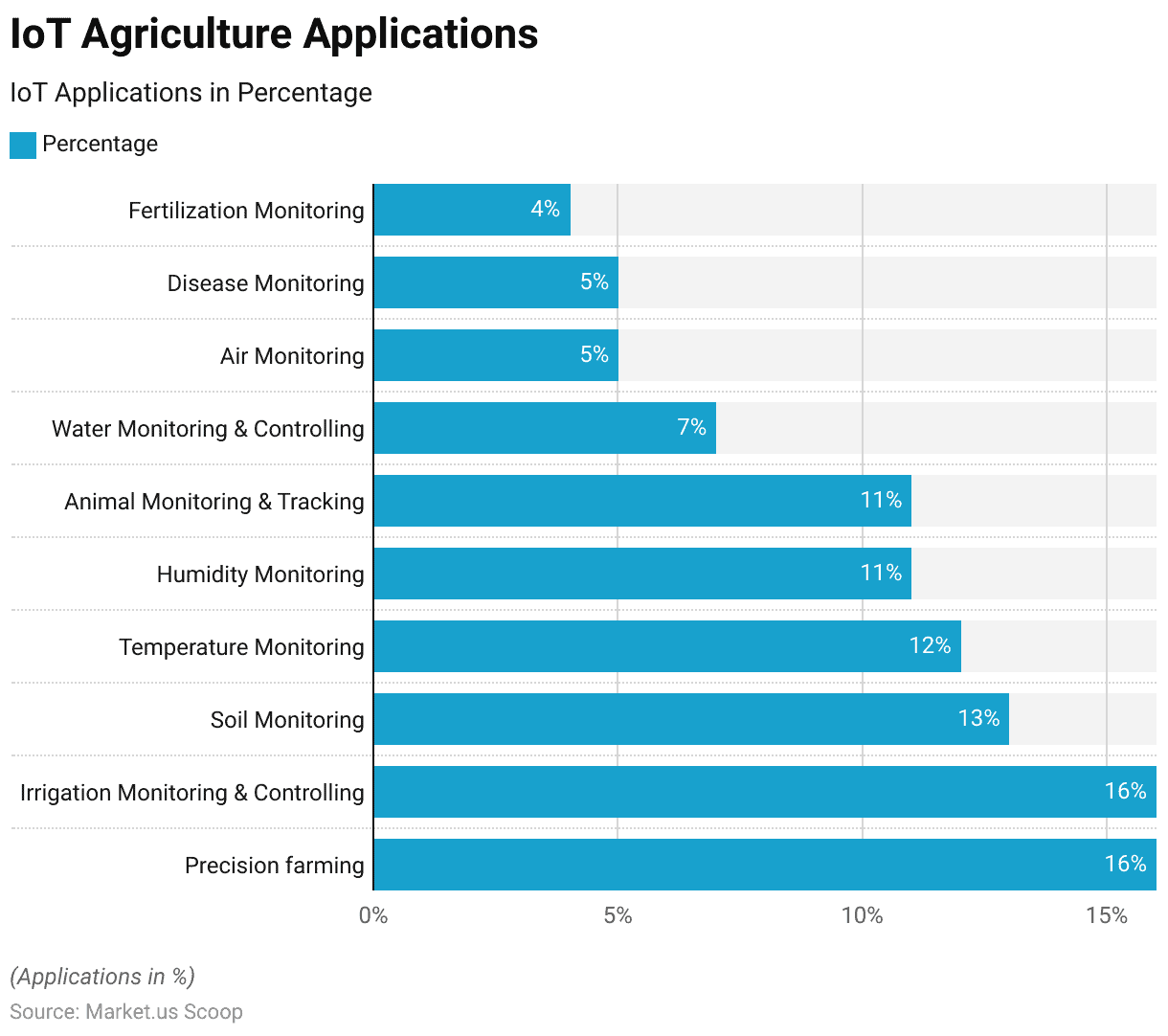
Farming Activities and AI Companies
- In the realm of farming activities, Artificial Intelligence (AI) has made substantial strides, offering innovative solutions through various companies.
- For weed control, Blue River Technology has pioneered AI-driven systems.
- When it comes to harvesting and packaging, Harvest CROO Robotics leads the way with automation.
- Diagnosing pests and soil defects finds its solution in PEAT’s AI technologies, while soil analysis benefits from Trace Genomics’ expertise.
- Crop health monitoring is efficiently handled by SkySquirrel Technologies, ensuring the well-being of crops.
- Blue River Technology also makes an appearance in lettuce thinning, further showcasing its AI prowess.
- Self-driving tractors, a groundbreaking innovation, are championed by Autonomous Tractor Corp.
- Finally, for predicting weather, pests, and diseases, aWhere utilizes AI to provide invaluable insights.
- These examples collectively demonstrate the breadth of AI applications in agriculture, addressing diverse farming needs and revolutionizing the industry for increased efficiency and productivity.
(Source: California Management Review)
Key AI in Agriculture Initiatives Statistics
- In April 2021, India and the United States launched the US-India Artificial Intelligence (USIAI) Initiative through the Indo-U.S. Science and Technology Forum (IUSSTF), a jointly funded autonomous organization. This initiative enables India to harness American AI technology to enhance food grain production in agriculture.
- In December 2020, scientists from the USDA Agricultural Research Service’s Western Human Nutrition Research Center (WHNRC) at the University of California, Davis, collaborated with over 40 researchers from six organizations to establish an institute focused on utilizing artificial intelligence (AI) for advancing the future of the food system.
- In December 2023, China unveiled its first vertical plant factory in Chengdu, Sichuan Province, developed by the Institute of Urban Agriculture (IUA) at the Chinese Academy of Agricultural Sciences (CAAS). This innovative system employs AI-driven robots that can efficiently grow and harvest lettuce in just 35 days.
- In June 2022, Israel initiated a strategic effort to integrate satellite technology and AI into agriculture. With the collaboration of the Israel Space Agency, a satellite will be used to map agricultural regions and determine suitable crop cultivation areas.
- This satellite will also assess soil conditions, including moisture levels, crop compatibility, pest presence, and other factors. Additionally, AI tools will be created to enhance decision-making and gather fresh insights for the agricultural sector.
- In September 2023, the Indian Union Ministry of Agriculture & Farmers Welfare introduced an AI Chatbot for the Pradhan Mantri Kisan Samman Nidhi (PM-KISAN) Scheme. This AI Chatbot launch signifies a notable advancement in improving the efficiency and outreach of the PM-KISAN program while ensuring farmers receive quick, precise, and clear responses to their inquiries.
(Source: Future Farming, USDA, Global AG Tech Initiative, English News, PIB)
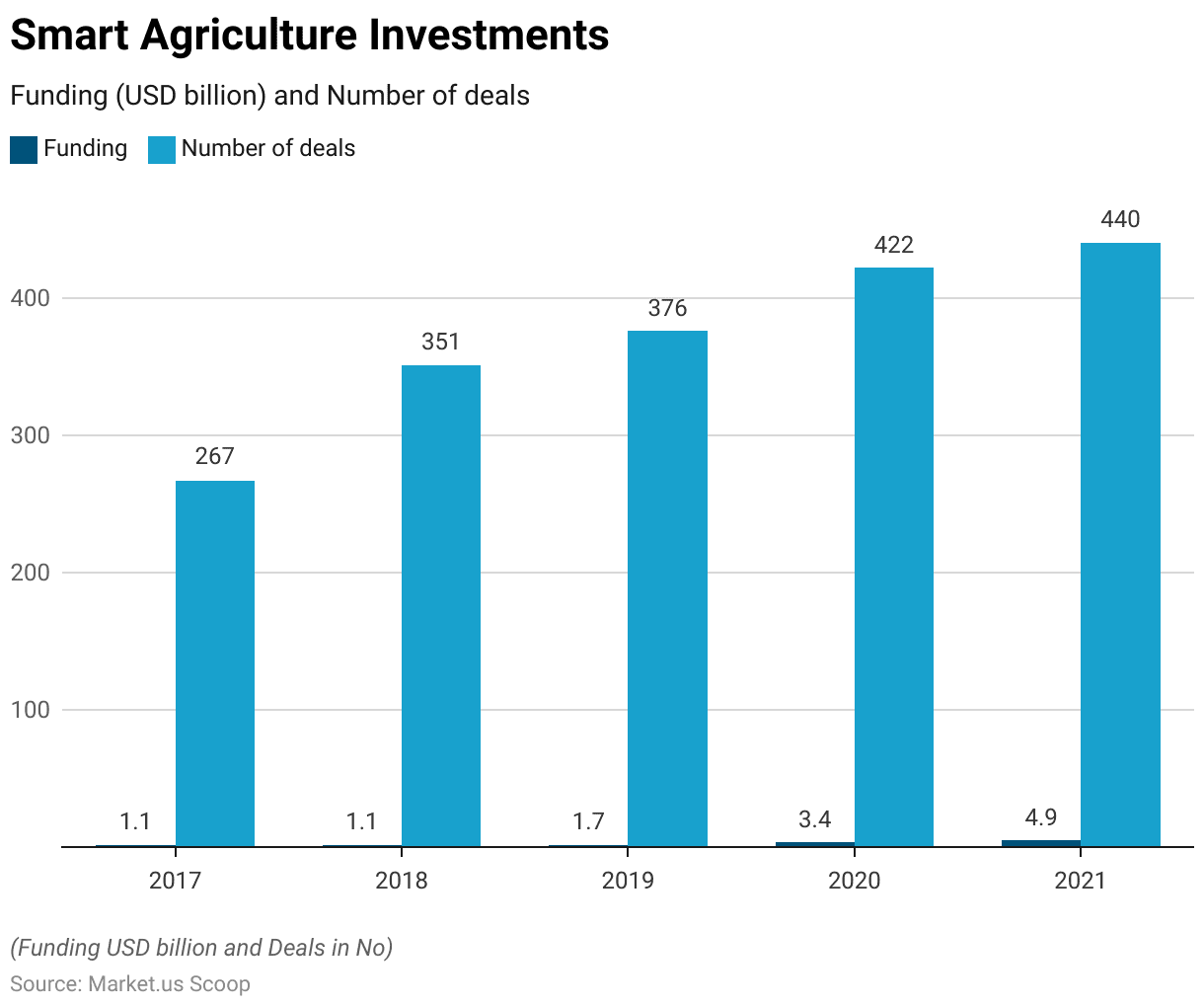
Smart Agriculture Investment Statistics
- Investments in smart agriculture have been steadily increasing in recent years.
- In 2017 and 2018, funding stood at USD 1.1 billion, with 267 and 351 deals, respectively.
- However, there was a noticeable uptick in 2019, reaching USD 1.7 billion across 376 deals.
- The momentum continued to grow in 2020, as the sector attracted USD 3.4 billion in funding through 422 deals.
- In the most recent data from 2021, smart agriculture investments surged to USD 4.9 billion across 440 deals.
- These figures reflect the growing interest and confidence in the potential of technology-driven solutions in agriculture to address the evolving challenges faced by the industry.
- The Smart farming market accounted for USD 19.5 billion and is expected to reach USD 53 billion in 2032. At a CAGR of 10.5%
(Source: Crunchbase)
Smart Agricultural Equipment and Artificial Intelligence
- Drones have gained significant popularity in agritech for tasks like crop assessment, imaging, and data collection.
- Agricultural drone usage constitutes 11 percent of the global drone market.
- The market values for all aspects of smart crop monitoring are anticipated to experience growth by 2027, particularly in automation and robotics, which are projected to surpass 1.1 billion U.S. dollars. Autonomous machinery finds applications in tasks like plant spraying, harvesting, and planting.
- The global market for autonomous harvesting equipment is expected to reach approximately 7.7 billion U.S. dollars by 2027.
- While spraying equipment currently holds the largest market share, it is estimated to grow by around 240 percent from 2021 to 2027.
(Source: Statista)
Conclusion
AI In Agriculture Statistics – In summary, Artificial Intelligence (AI) has emerged as a game-changing influence in agriculture. Its diverse applications, including precision farming, crop monitoring, and supply chain optimization, have transformed the agricultural landscape. AI’s data-driven insights empower farmers and agribusinesses, leading to improved productivity, sustainability, and resource utilization.
As AI technology advances, its incorporation into agriculture holds the promise of further progress, meeting the worldwide need for efficient, sustainable, and adaptable food production systems. Despite existing challenges, the potential of AI in agriculture is unquestionable, presenting a bright future for the industry and its participants.
FAQs
AI in Agriculture refers to the utilization of artificial intelligence technologies like machine learning, computer vision, and data analytics to enhance farming practices, improve crop management, and optimize various aspects of the agricultural sector.
AI benefits agriculture by enabling precision farming, automating tasks, monitoring crop health, predicting weather and pest patterns, and enhancing resource management. It leads to increased productivity, reduced environmental impact, and more sustainable practices.
AI applications in agriculture include crop monitoring, autonomous tractors, pest detection, yield prediction, soil analysis, and supply chain optimization, among others.
Challenges include the cost of technology adoption, data privacy concerns, access to AI expertise, and ensuring compatibility with existing farming practices.
AI can enhance food security by increasing agricultural productivity, improving crop yield predictions, and ensuring efficient supply chain management.
Discuss your needs with our analyst
Please share your requirements with more details so our analyst can check if they can solve your problem(s)



